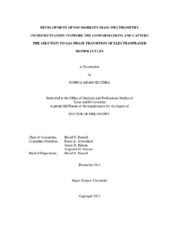| dc.contributor.advisor | Russell, David H | |
| dc.creator | Silveira, Joshua A | |
| dc.date.accessioned | 2014-05-13T17:20:58Z | |
| dc.date.available | 2015-12-01T06:31:15Z | |
| dc.date.created | 2013-12 | |
| dc.date.issued | 2013-11-22 | |
| dc.date.submitted | December 2013 | |
| dc.identifier.uri | https://hdl.handle.net/1969.1/151729 | |
| dc.description.abstract | Recent progress has been made developing ion mobility-mass spectrometry (IM-MS) instruments for biophysical studies; however, experimental techniques that can probe the structure and/or dynamics of biomolecules at intermediate extents of hydration are limited and little is known about the final stages of desolvation during electrospray ionization (ESI). Here, ion optical devices, analytical methodology, and instrument platforms are developed to study the conformations of structurally labile biomolecules (i.e., peptides and proteins) produced upon ESI and provide new insight into their solution to gas phase evolution.
First, fundamental principles of periodic focusing ion mobility spectrometry are comprehensively discussed. Radial ion confinement is attributed to a collisionally dampened effective potential that ultimately results in high ion transmission. Detailed equations of motion are derived that culminate into useful methodology for accurate determination of peptide and protein collision cross section values via inclusion of a mobility dampening coefficient.
Second, evaporation of water from extensively hydrated protons and peptides formed by ESI is examined for the first time using a new cryogenic (80 K) IM-MS instrument platform. Key parameters that influence the cluster distributions are critically examined. In agreement with previous studies, the findings indicate that water evaporation is largely dependent upon the particular charge-carrying species within the cluster. IM-MS results for protonated water clusters suggest that the special stability of the well-known H^(+)(H_(2)O)_(n) (n = 21) “magic number” cluster is attributed to the presence of a compact clathrate cage isomer produced upon ESI. Peptide studies are also presented in which specific and nonspecific solvation is observed for gramicidin S [GS + 2H]^(2+) (H_(2)O)_(n) (n = 0 to 26) and bradykinin [BK + 2H]^(2+) (H_(2)O)_(n) (n = 0 to 73), respectively. However in the case of substance P, [SP + 3H]^(3+), the results demonstrate that a compact dehydrated conformer population (resulting from the evaporative ESI process) can be kinetically trapped on the time scale of several milliseconds, even when an extended coil conformation is energetically favorable in the gas phase. | en |
| dc.format.mimetype | application/pdf | |
| dc.language.iso | en | |
| dc.subject | mass spectrometry | en |
| dc.subject | ion mobility spectrometry | en |
| dc.subject | periodic focusing ion guide | en |
| dc.subject | gas phase hydration | en |
| dc.title | Development of Ion Mobility-mass Spectrometry Instrumentation to Probe the Conformations and Capture the Solution to Gas Phase Transition of Electrosprayed Biomolecules | en |
| dc.type | Thesis | en |
| thesis.degree.department | Chemistry | en |
| thesis.degree.discipline | Chemistry | en |
| thesis.degree.grantor | Texas A & M University | en |
| thesis.degree.name | Doctor of Philosophy | en |
| thesis.degree.level | Doctoral | en |
| dc.contributor.committeeMember | Batteas, James D | |
| dc.contributor.committeeMember | Schweikert, Emile A | |
| dc.contributor.committeeMember | Musser, Siegfried M | |
| dc.type.material | text | en |
| dc.date.updated | 2014-05-13T17:20:58Z | |
| local.embargo.terms | 2015-12-01 | |


